
Social media marketing requires both strategy and creativity. While it may seem overwhelming, its importance cannot be overstated. It’s so important that >
around 92% of marketers use social media as part of their marketing efforts. In addition to that,
78% of salespeople engaged in social media are outselling their peers who aren’t. Plus, its benefits extend far beyond increasing sales.
However, not all businesses are aware of the benefits of social media marketing. In fact,
nearly 40% of small businesses don't use social media. Even more concerning is that an additional 16% are unlikely to use social media for business at all.
Clearly, there’s a disconnect between
those who are seeing the benefits of social media and those struggling to get started. If the latter sounds like you, keep reading. You’re about to learn how
social media marketing can help build your business. Some of the benefits you’ll learn about include:
- Growing your brand awareness: Social media marketing will make it easy to spread the word about your products and mission.
- Increasing your traffic: Using social media and linking it to your website will increase your traffic tremendously.
- Promoting your products and services: This is ultimately why you invest in marketing, right?
In order to survive in a competitive market, you need to be aware of new trends in your industry. In fact,
72% of companies use social media data to make informed business decisions. So how can you rise up from the competition and ensure your business is doing everything it can to succeed? By using social media, of course. Below are 20 reasons why you should implement social media into your business’s marketing strategy.
1. Builds Brand Awareness and Recognition
Gaining brand awareness and brand recognition is one of any business’ most important marketing goals. That’s because
consumers want to buy brands they recognize. Many shoppers even have certain degrees of brand loyalty, which leads to long-term business benefits. Thankfully, social media allows for easy and effective brand building.
Social media has a benefit over traditional media because it can get your brand in front of people much more quickly and easily. Furthermore, it gets your audience looking at your brand even when they aren’t thinking about your brand or product.
Tip: Pay attention to your profile and cover photos. A great way to create brand recognition is to place your logo often, yet strategically. You want to make sure that it’s not overwhelming or distracting.
Make sure the visual elements of your brand are well represented.

Take a look at
Adidas' Twitter page. Adidas keeps their Twitter profile neat and clean. They place their recognizable logo on both their profile image and cover photo without being overbearing. This cover photo is especially effective because it showcases adidas’ products while enforcing their brand name.
2. Generates Conversation Around Your Brand
A strong social media marketing strategy will generate conversation about your brand, products, and partners.
Take this example from
Xbox Game Pass on Twitter. They simply tweeted to announce the availability of one of their games on EA Play. By doing this, they received a great amount of feedback about their product. They also got people talking. Fans were having genuine conversations, all facilitated by social media.


Tip: Engage with your audience when they comment on your social media messages. Make sure they feel that there is a person behind the brand. Ensuring they feel like they’re not talking to a robot will give them a better perception of your company and make them feel more like a valued customer.
Focus on sharing content that naturally creates conversation. Some of those ways are to:
- Give shout-outs to other companies you network and work with.
- Solicit feedback about your products.
- Ask open ended questions, then let the audience reply to get them actively involved.
3. Helps Understand Your Target Customers’ Interests
You need to know what your target customers are interested in if you’re going to try to reach them effectively. You can do this by monitoring their social conversations around certain topics. This is called
social listening, and can help you understand what’s important to your audience while identifying trends they’re following. You may also learn about what they’re struggling with, which can help you create content addressing those pain points.

Take a look at
Belk on Twitter. Their target audience’s interests align strongly with the women empowerment message portrayed in this tweet. By aligning themselves with the same value, they create a stronger bond with their target audience. If you’re unsure how to match your target customers’ interests, social listening can help.
Tip: Make it part of your daily routine to do some social listening and see what your target customers are talking about in your industry. If you want to take your social listening to the next level, check out
Mention (the same social listening tool used by the CoSchedule team).
4. Provides Platforms to Tell Your Brand’s Story
Using social media is a great way to share your brand’s mission and share stories.
Effective storytelling can have a great impact on your brand’s image. These stories can be simple or extensive depending on what you think will be most effective.
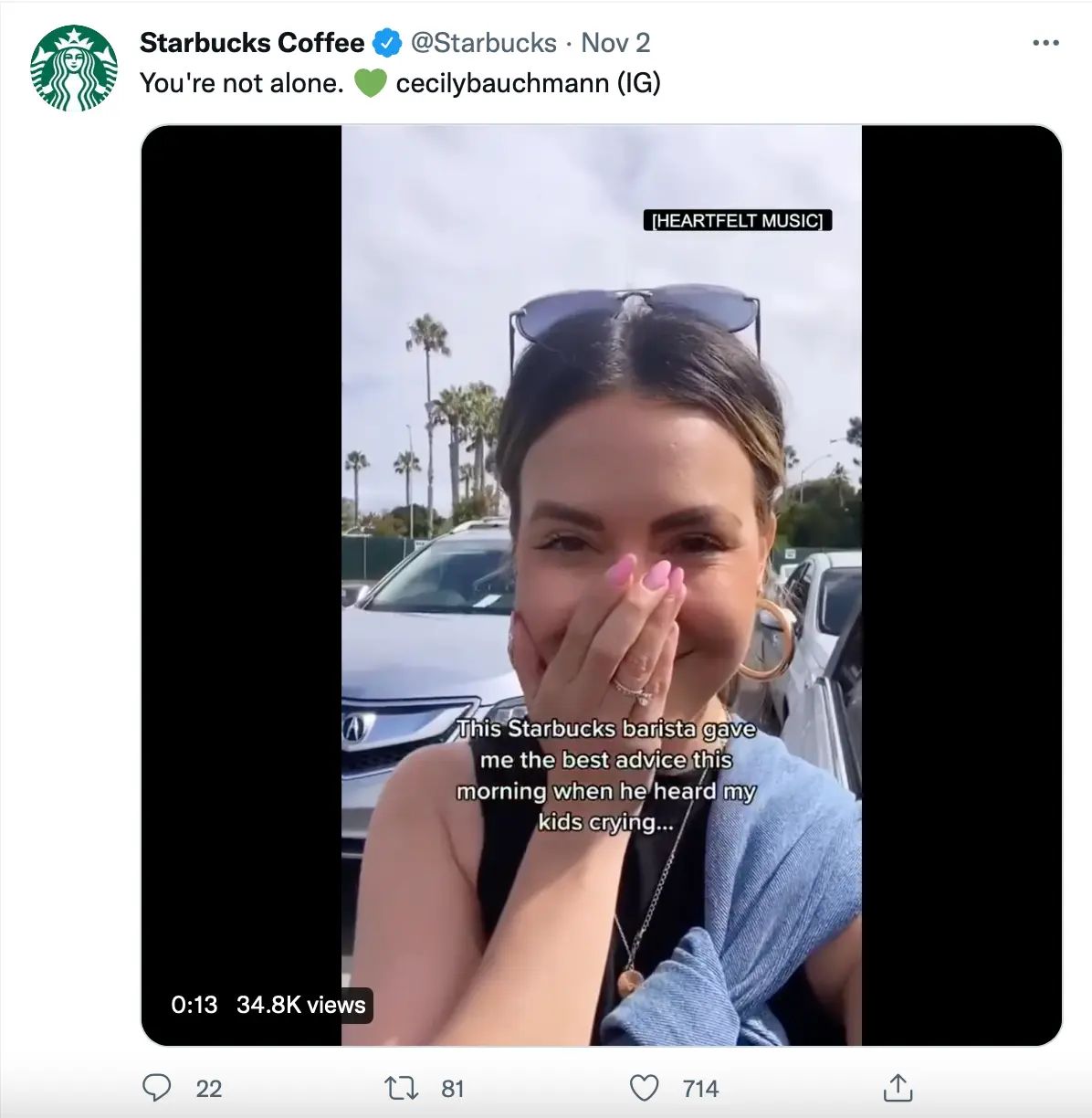
Take this
Starbucks post for example. They chose to share a video that tells the story of a customer who had a heartwarming experience at a Starbucks drive-through. Not only did they show how they impacted one of their customers, but they also spread the message that their product (or service) is effective enough for someone to give them positive feedback.
Tip: Not all stories have to be long and complicated. You can tell impactful and clear stories by using a simple image. As long as it tells a good story, it can effectively help your business’s public image.
5. Helps You Gather Data About Your Audience
Audience research is similar to social listening. It searches the keywords your audience will be using, but it’s more focused on your specific product. You can use social media to gather this information.
Tip: Many social media platforms allow you to view the reach and insights of all your posts.
To view the insights on your
Facebook page:
- Go to the page that you are the admin of
- Scroll down the “Manage Page” section on the left side of the screen
- Click on “Insights”
- Scroll down and click on “People” to see specific audience analytics
To view the insights on your
Twitter page:
- Go to the tweet you want to see the analytics for
- Underneath the tweet, click on the “analytics” icon on the far right, or...
- On your Twitter page, click on the “More” tab on the left side of your screen
- Click on “Analytics” to see broad metrics that aren’t specific to any post
To view the insights on your
Instagram page on the mobile app:
- Go to your profile
- Click on the “Insights” button
- Scroll down to “Your Audience” and click on “See All”
6. Helps Provide Responsive Customer Service
Customers now expect companies to handle their requests through social media. A strong investment in customer service can build meaningful relationships between your company and your customers. With social media, the challenge of customer service remains as demanding as it had before.
Social media allows for immediate interaction and customer feedback. Businesses can also respond to their customers right away.
71% of consumers who have had a positive experience with a brand on a social media platform said they were more likely to recommend that brand to the people they know, so having a social media customer service strategy is extremely important.
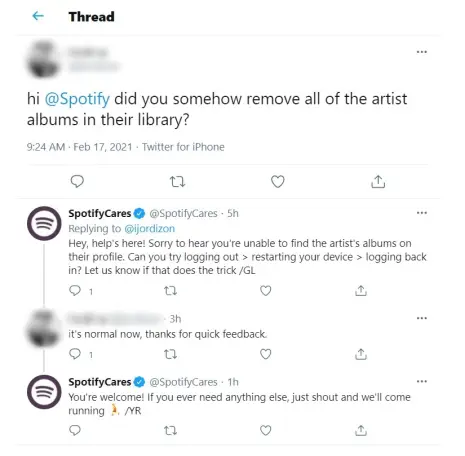
Take this example from
Spotify's support Twitter account. A customer decided to ask a question via Twitter, and Spotify was able to answer it and help resolve the issue within a couple of hours.
Tip: Assuming that you have separate teams for social media and customer service, it’s important to maintain a strong line of communication between the two. That way, your teams don’t get tangled up when providing customer service through social media.
7. Helps Build Customer Loyalty
What could possibly be better than building brand loyalty for free? Customers follow and interact with the brands they enjoy. In fact,
90% of people say they buy from brands they follow on social media.
It’s an obvious direct correlation: If customers follow you, they are more likely to choose you versus your competition. Furthermore, if they’re loyal customers, they’ll increase your traffic.
Tip: Be sure to keep your loyal audience engaged and happy. Here are a few ideas:
- Offer promo codes for discounts through social media to your followers (while remaining mindful of Facebook's promotional content guidelines).
- Ask open-ended questions that allow your audience to reply.
- Give away inexpensive things such as stickers, patches, shirts, sunglasses, lanyards, hats, and Koozies that will make a long-lasting impression.
8. Helps Drive Traffic to Your Website
Social media marketing can assist in sending customers directly to your site. Search engines are great, but being overly reliant on search results means you’re missing out on a ton of potential traffic. Social media channels allow for more diverse inbound traffic streams.
Though social networks are great for getting traffic to your site, you need to consider not only
what to post, but how often to post as well. You don’t want to become that overbearing marketer, or you’ll turn off your customers.
It’s good to
follow a set schedule for posting your content. This helps ensure your content is posted consistently.
Tip: Use bit.ly to shorten your links and place them within your posts and profiles. The shortened links will save space and not look overbearing to the audience. (You can do this with the bit.ly integration in your CoSchedule
social media calendar.)
Below, Best Buy used a bit.ly link to bring people from their tweet to their website.
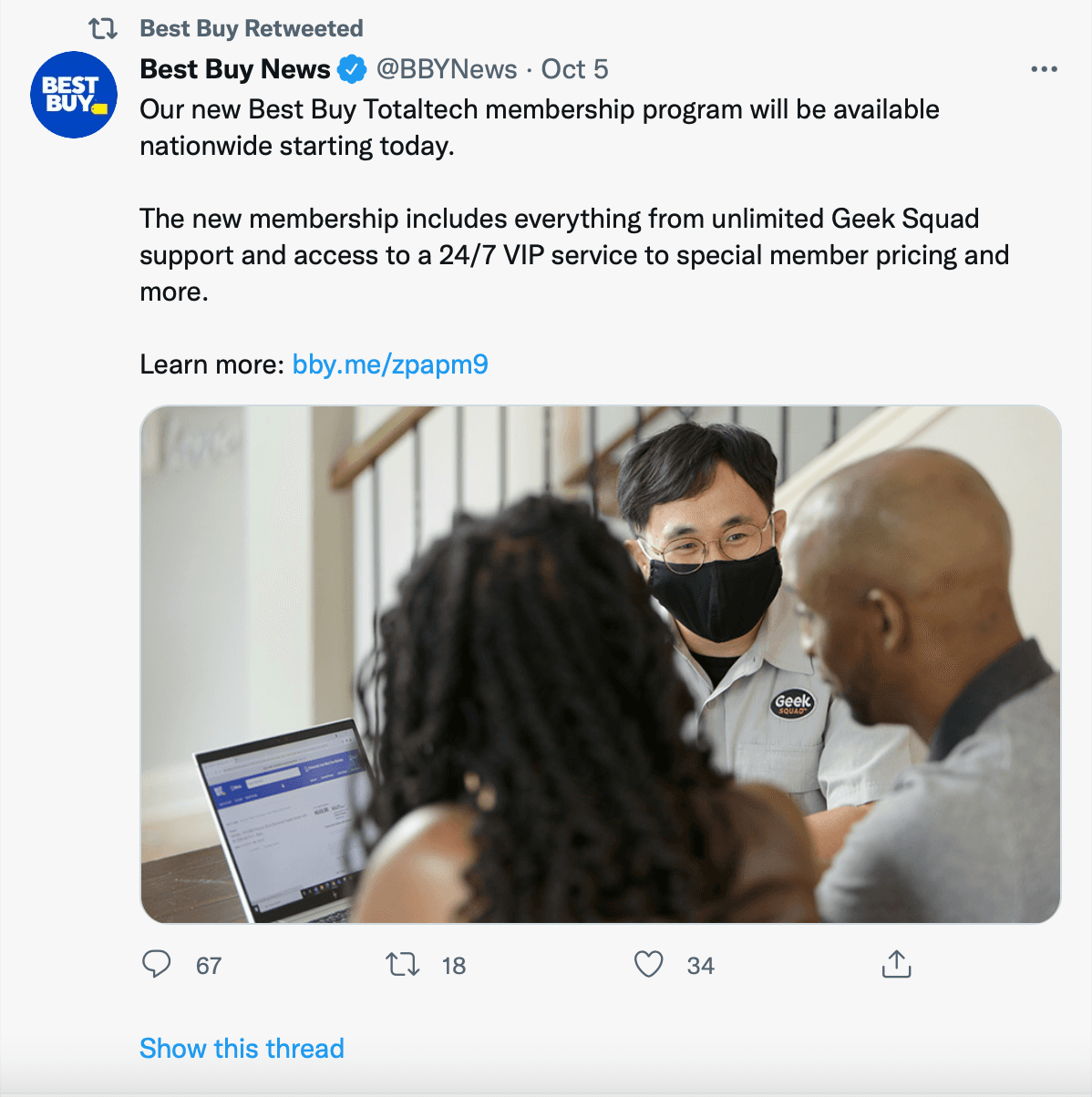
9. Tweets Can Show Up in Google Searches
Social media can assist with link building and may have an
indirect impact on SEO.
Google and Bing display tweets in search results. This feature allows people to see what others are saying about the topic they are interested in. It is more relevant for topics that are trending, as newer tweets will pop up on the search engine results page.
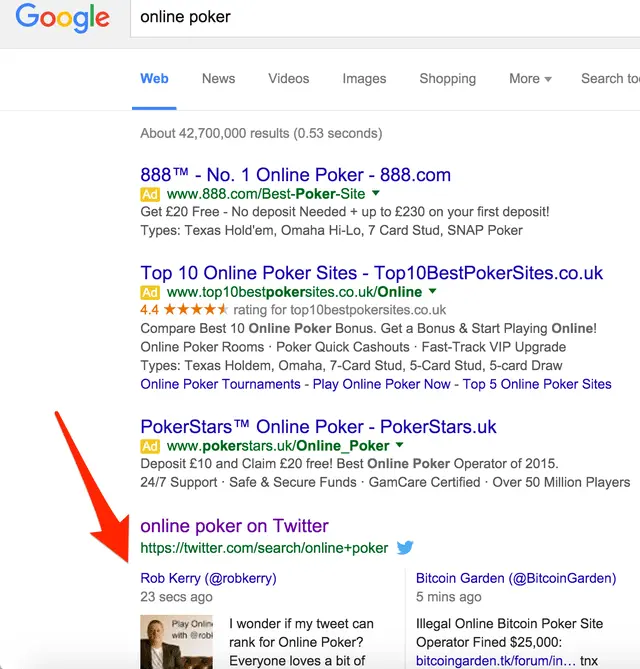
Tip: Using a social media scheduling tool like
CoSchedule's Marketing Calendar can help you plan your social media posts so your content can be found and be linked to.
10. Helps Identify and Connect With Potential Business Partners and Collaborators
Social media makes it possible to make connections with new people. Here are some ways you can leverage this to benefit your business:
- Facebook Groups: 1.8 billion people use Facebook groups. With tens of millions of groups on Facebook, chances are that you’ll meet some potential business partners in a few of those. Finding those groups and getting involved can help you make connections with those who might want to collaborate with your brand.
- LinkedIn: LinkedIn was made to help professionals connect with potential business partners, collaborators, or employees/ employers. In fact, 72 % of B2B Buyers use LinkedIn to share important information about their business. By using LinkedIn’s network of over 467 million members, you can do your research and find those who might want to collaborate.
- Twitter: Not only does Twitter allow you to reach customers, but it also acts as a platform to reach the right people for your business. You can take advantage of Twitter's list function to create groups of people who might be helpful to your social media goals. Then, you can target your engagement to those potential business partners.
- Instagram: Instagram has become one of the best platforms to reach brand collaborators and content creators. In fact, Instagram collaborations are on the rise and influencer marketing is expected to grow to be worth over $13.8 billion. Creators on Instagram now have the ability to add brands to their preferred “brands list” to communicate who they would be open to collaborating with. This also gives creators priority when businesses start searching for new people to work with.
Tip: Consider building your own Facebook or LinkedIn group about the industry you’re in. You can see conversations about the industry as a whole that can help you with your marketing and product development.
11. It’s Cost Effective
Organic social media marketing is (mostly) free. It’s free to create social media profiles and post organic content. For some, that may be enough, and the quality of the content may promote the content on its own. However, if you’d like to go the extra mile and promote it further, paying for promotion will help increase exposure.
Tip: Don’t write organic content that sounds like an ad. It’ll make your posts look like spam. If it sounds like an ad or includes a transactional
call to action (ex: Buy Now, 30% Off, Use This Coupon Code), you should pay for it. Many marketers look at social media as a way to blast free advertising, and social media platforms have caught on to that idea and are restricting the reach for unpaid-for ads. By all means, if you want to advertise on social media, you should. But make sure you pay for it so that it looks professional and you get a good reach.
12. Helps With Repurposing Content
Everyone knows recycling is good, so why not recycle your content? You put a lot of work into it, and it deserves to be seen. You can repurpose the same content that you have on a blog post or video, and place it on your social media platforms. This allows you to reach an audience that might have missed your content the first time around. It also helps strengthen your
brand's messaging and can even give your content an SEO boost.
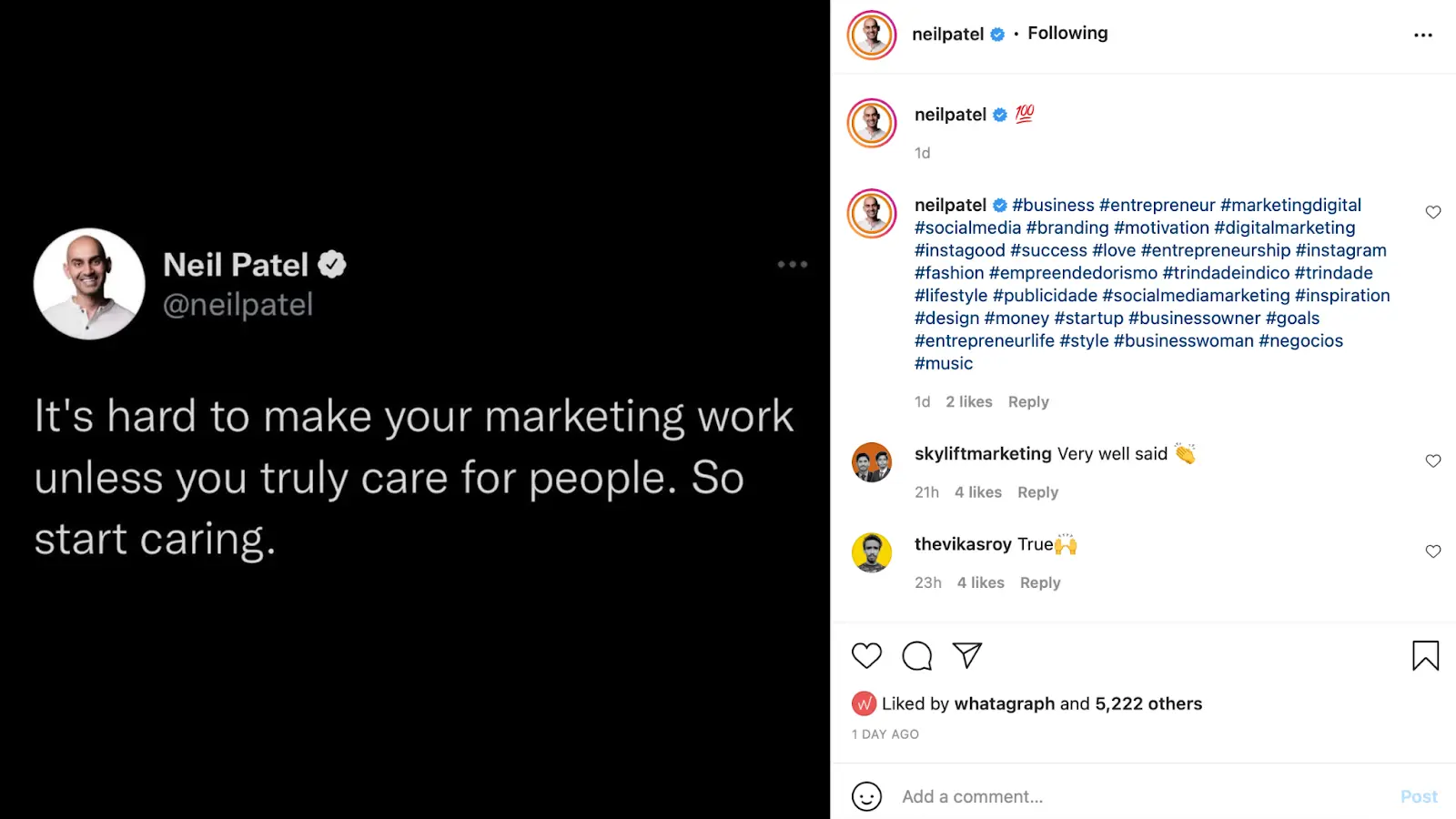
For example,
Neil Patel frequently uses his tweets as Instagram posts. By doing this, he reaches those who might not have a Twitter account. If someone follows him on both platforms, this gives him an opportunity to show up on their feed more than once.
Tip: Repurposing content doesn’t just mean posting it in more than one place. You can slightly alter each post to make it more unique. For example, you can use social media to promote your podcast by posting a quote from your most recent guest on Twitter or Instagram. It won’t be exactly the same content, but a majority of the work is already done and this is a quick way to fill your
social media calendar.
13. Social Media Retargeting Ads Can Re-engage Website Visitors
Retargeting is a wonderful tool for social media marketing. Generally,
92% of consumers will visit a brand’s website for the first time to do something other than make a purchase. While getting the 8% is great, advertising can help reel in the 92% that left before they had a chance to purchase anything. One way to do that is to run
retargeting ads.
Retargeting works by keeping a list of people who visit your site and placing anonymous “cookies” within their browser. When they visit a social media site, a retargeting service then displays the ads. This allows for your business to be in the eyes of the customer beyond just when they’re on your site.
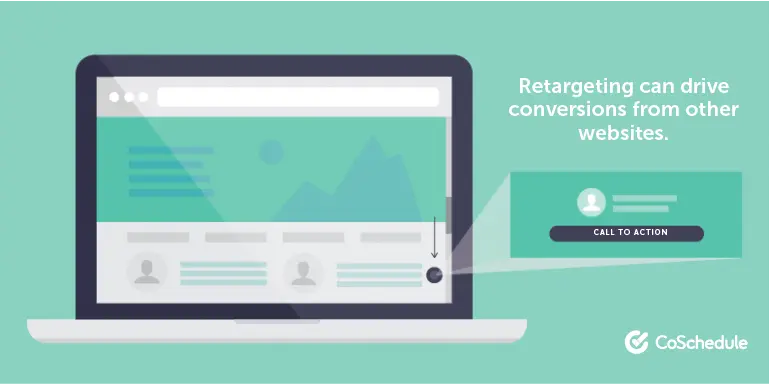
Tip: There are some great
retargeting tools out there that are easy to use. Check out those tools and find one that works for you. Use them to promote your product. But remember not to annoy your customer.
14. Makes It Easy to Distribute Content
You’ve worked hard to create unbelievable, unique content and now it’s time to put it out for the world to see. Luckily for you, social media can help you distribute your content to reach your target audience. Not only are you able to post organic content on each platform, but you can also promote other content through your posts as well.
Everyone wants their content to have an audience, and social media is a great way to help it get seen. In fact,
9,729 tweets are sent each second. In addition to that, there are an estimated
5.6 billion Google searches each day. As stated before, social media posts, like tweets, can rank on Google, so that’s a lot of opportunity for your content to be seen by the right people.
There are even integrations that allow you to post the same content on multiple platforms at the same time. For example, Instagram allows you to post on Facebook while it’s publishing your content. Facebook is currently testing a new option for
cross-posting to Instagram, so you can share content both ways. Simply turn the switch in your share settings and you’ll be reaching a wider audience in no time.

Tip: By using a
social media calendar, you can plan your social media content ahead of time. Then, when it’s time to publish, you can just sit back and let the platforms do their jobs. You’ll be able to reach different audiences on each platform and really expand your reach.
15. Helps You Stay Current With Industry News
It’s already been established that social media can help you connect with potential collaborators or business partners involved in your industry. In addition to that, by following and monitoring your competition and other industry businesses, you can see what new things they’re trying to accomplish.
Technology, social media, and marketing practices are always evolving. When someone within your industry makes a sudden change, you’re going to want to know about it and figure out why. Keeping up on news that might affect you and your company is necessary in order to stay afloat in a competitive market.
For example,
Google changes its algorithm quite frequently. If you want to stay up to date on how it works so you can see how the changes will affect your SEO, you might want to follow them on
Twitter. This way, you can stay current with news that affects your business.
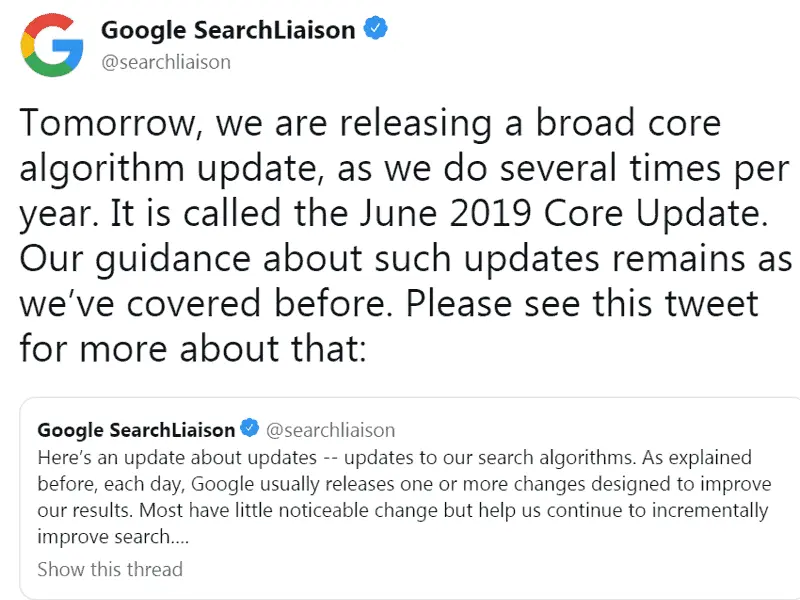
Tip: When learning about industry changes, you’ll want to ask yourself questions to see how it might affect you and your company. Social media helps give you a steady stream of information you can use to see how your company measures up and how you might have to adjust your strategy.
16. Social Proof Can Improve Content Performance
Let’s compare your website to a restaurant. Imagine yourself walking down the street looking for a place to eat. You see one restaurant that’s empty and one’s that packed. You’d most likely choose the packed restaurant, right? That’s the place with all the great food that people are going for. The same goes for your website.
No one wants to get the content that no one else cares about. They want the one that is doing well and being shared often. Obviously, the content of it must be worth getting a lot of shares. The content that is shared the most must have some authority or must be creative and original.
Take a look at how Woorank's Google Core Web Vitals blog post performed. When you hover over the plus sign, you can see just how many times that content was shared, and to which platform it was shared to. If a lot of people are sharing this content, others might be influenced to share it on a social platform too.
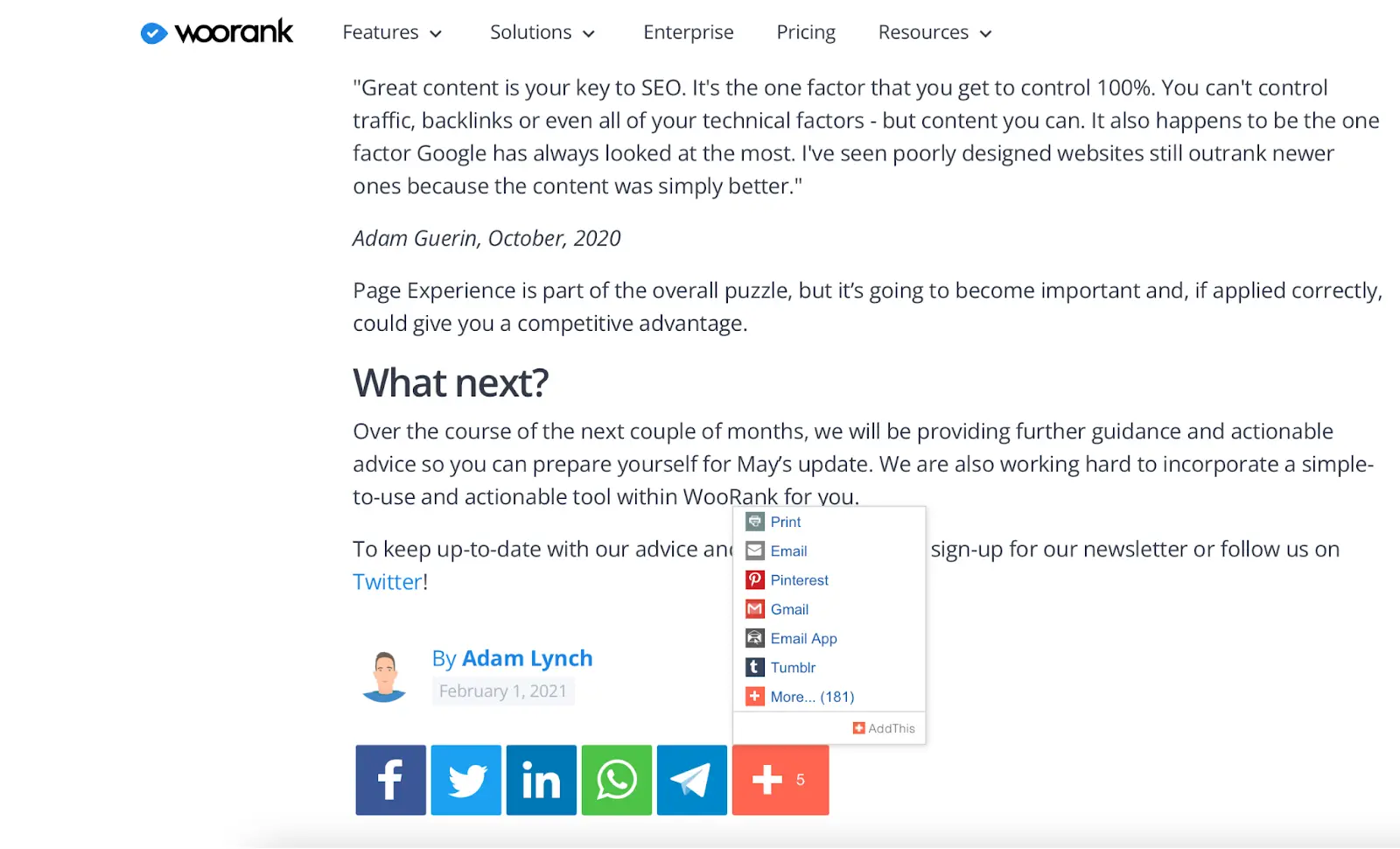
Tip: You can include
buttons on your blog and website to display how many shares your content has gotten. These buttons are convenient and allow for quick sharing.
17. Provides Outlets to Share Company News and Updates
Similarly to keeping up on industry news, social media is one of the best and easiest ways of keeping your customers updated with your news. If your business makes a huge announcement about a new product or an exciting event, it’ll catch on and get people excited.
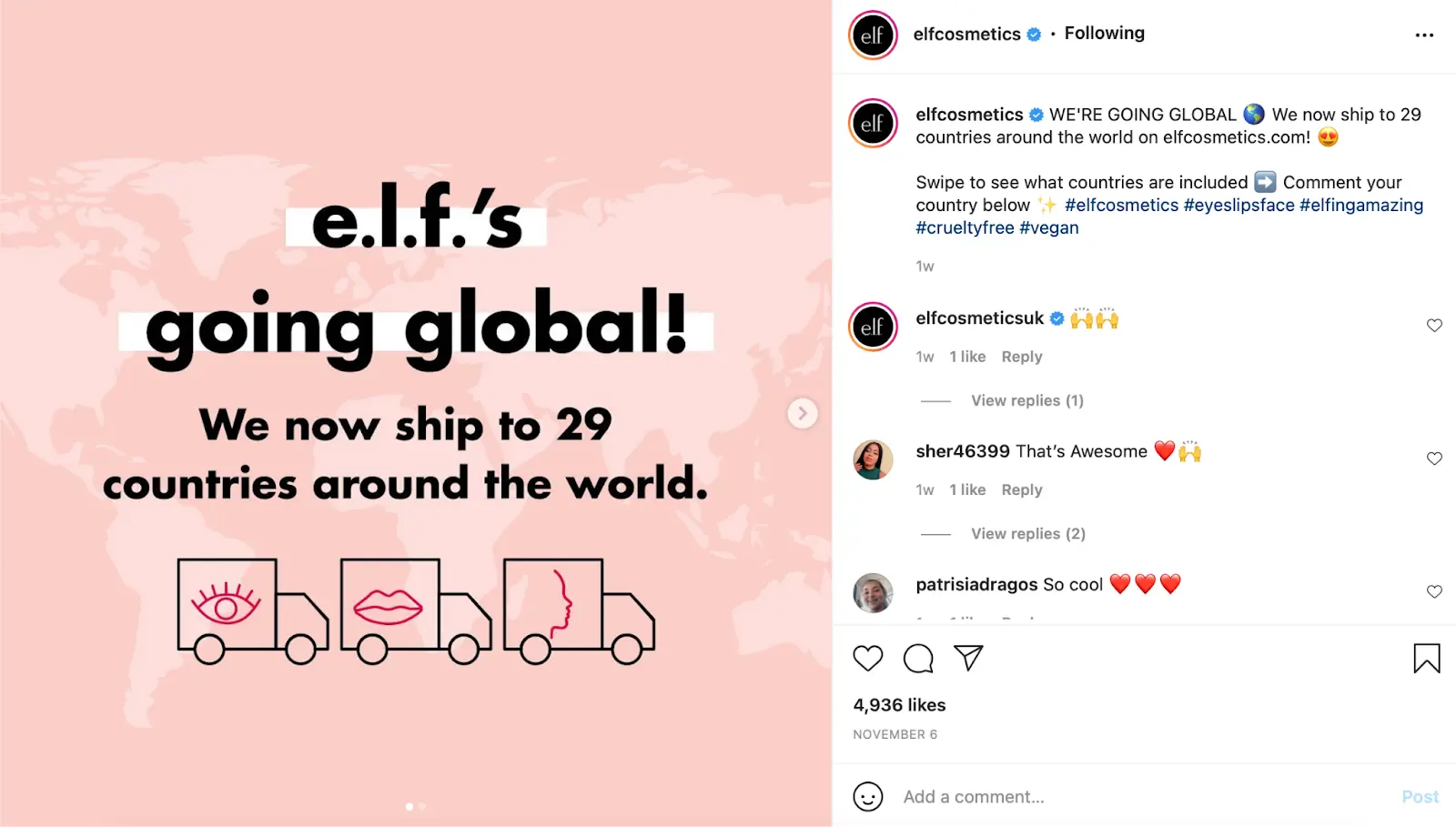
When
e.l.f. Cosmetics and Skincare announced they expanded where they were shipping products, a lot of people started talking about it. In just this one Instagram post, they received almost five thousand likes and over 200 comments.
Tip: So what type of news should you share?
- New products
- New services
- New updates
- New expansions or departments
You see the theme here: New.
18. Social Media Can Help Establish You As a Thought Leader
Everyone wants to be seen as a leader. You want people to look at you and your content first whenever they have a question. So how do you stand out ahead of the crowd of other business professionals in your industry?
Social media can help with that.
Social media allows you to reach an incredible number of people. Your potential audience is huge, so the first step is to narrow down who your target audience is, and then create content that relates to them. Social media not only allows you the opportunity to post great content, but it opens pathways for you to connect and engage with your followers. After you build that connection with them, they’re more likely to come back to you if they have a question about your industry.
For example,
Seth Godin uses Instagram to make connections with people and facilitate discussions about marketing. Marketers look to him and his blog when they have questions about a relevant topic. He uses social media to connect with those who see him as a thought leader.
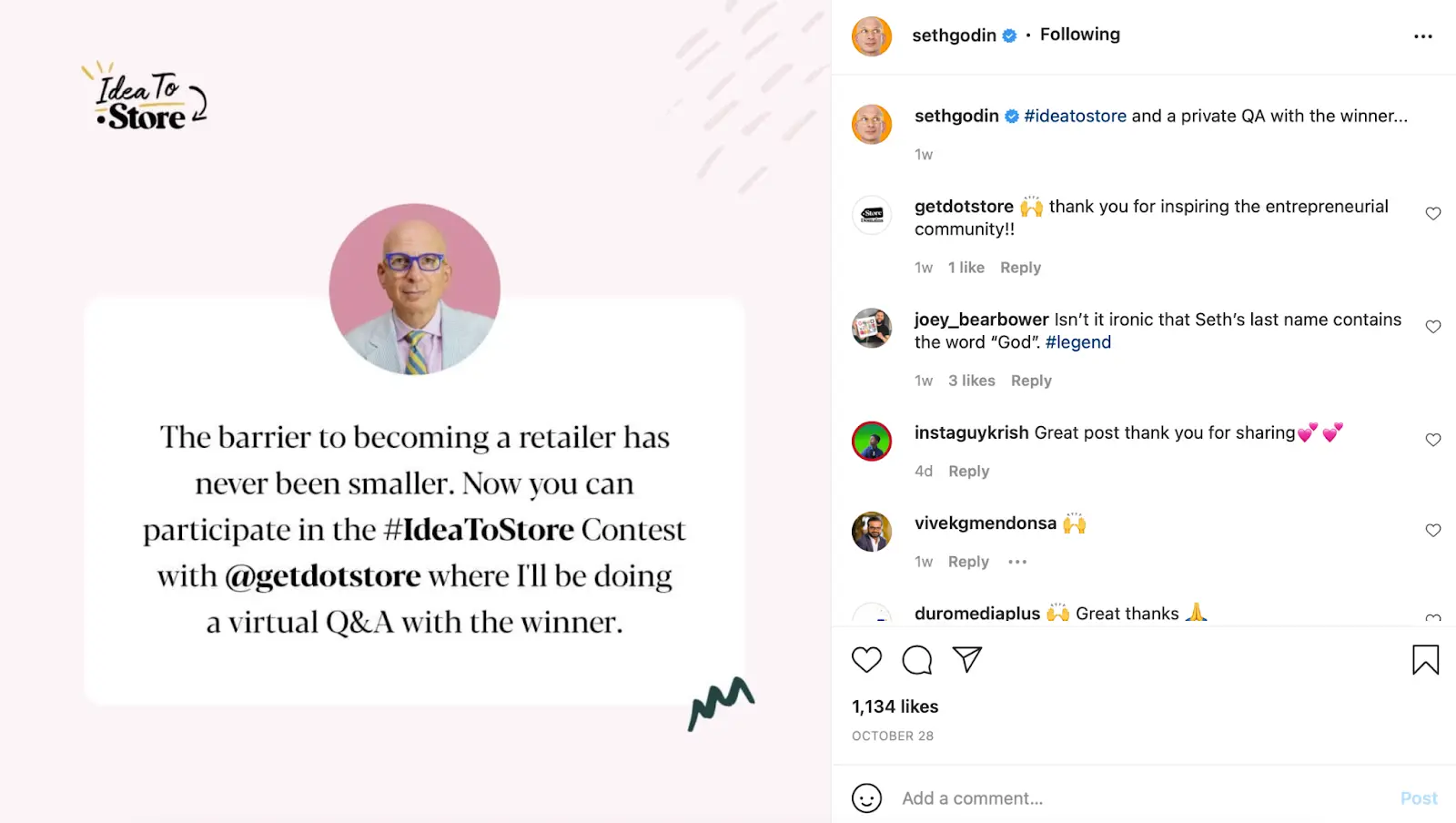
Tip: Establishing your company as a thought leader doesn’t happen overnight. If you want to be the first person people come to when they have a question, it’ll take some time. Start by asking questions about who you see as a thought leader. Ask questions like, “Who do I go to for answers?” “Who do others in my industry look to?” “How can I promote myself like they do?” Then, slowly take what you learn to make connections and drive discussion between your followers.
19. Can Help You Identify Trends in Consumer Behavior and Opinions
Social media can
influence consumer behavior. Understanding how much of an influence it has is important. Social media can also give you important insight to how your consumers make their purchase decisions and what their overall opinions are of current trends. How can you find out what these trends are? Hello again,
social listening.
Listening to what consumers are saying about your brand or products can help you discover what’s working in your strategy, and what are some user pain points. Understanding what values are important to your consumer can help you market to them. Social media platforms have created spaces for people to voice their opinions about the news, politics, products, or anything else that might be currently trending. Twitter even has a “What’s Happening” section on your homepage so you can see what consumers are saying about what’s trending.
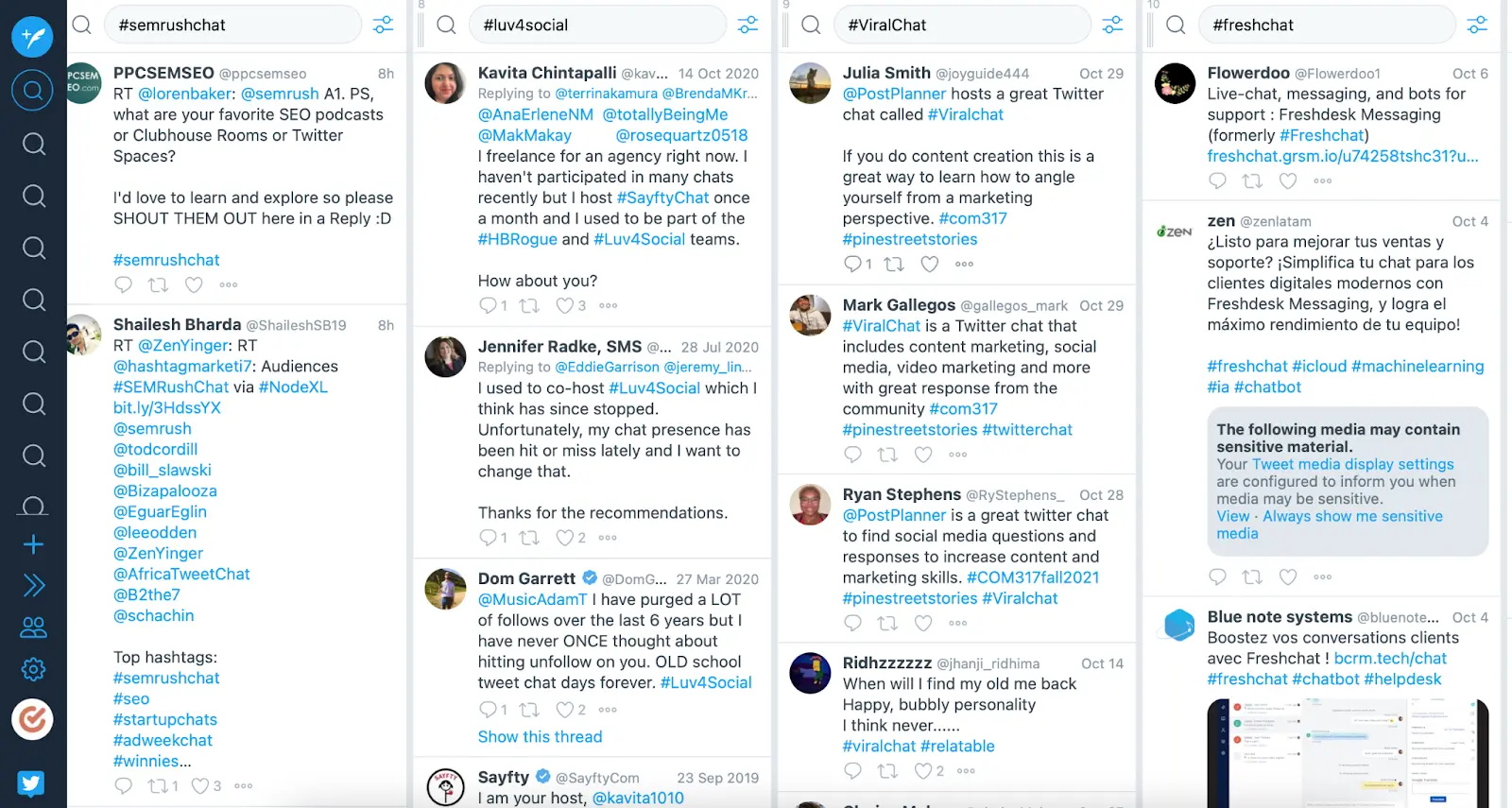
Tip:
TweetDeck is a social media listening tool that allows you to search for topics on Twitter to see what people’s opinions are about it. You can use this tool to see what consumers are saying about you and your competitors, along with any other keywords you might want insight on.
20. Can Help You Do Competitor Research
Almost everyone is on social media. At least,
4.48 billion people are... and that includes your competitors. That’s not necessarily a bad thing for you because you can
monitor their social media to get some pretty significant insights.
The first thing you need to do is identify who your competitors are and what their social media strategy is. You can do this by keeping a close eye on their social media profiles and analyzing what type of content they post. You can even use different analytic tools to see how you and your competitors compare.
Of course, you’ll be able to see how many likes each post gets, but if you want to dig deeper into how you compare to your competitors, you can use tools like
Rival IQ to see activity and engagement rates.
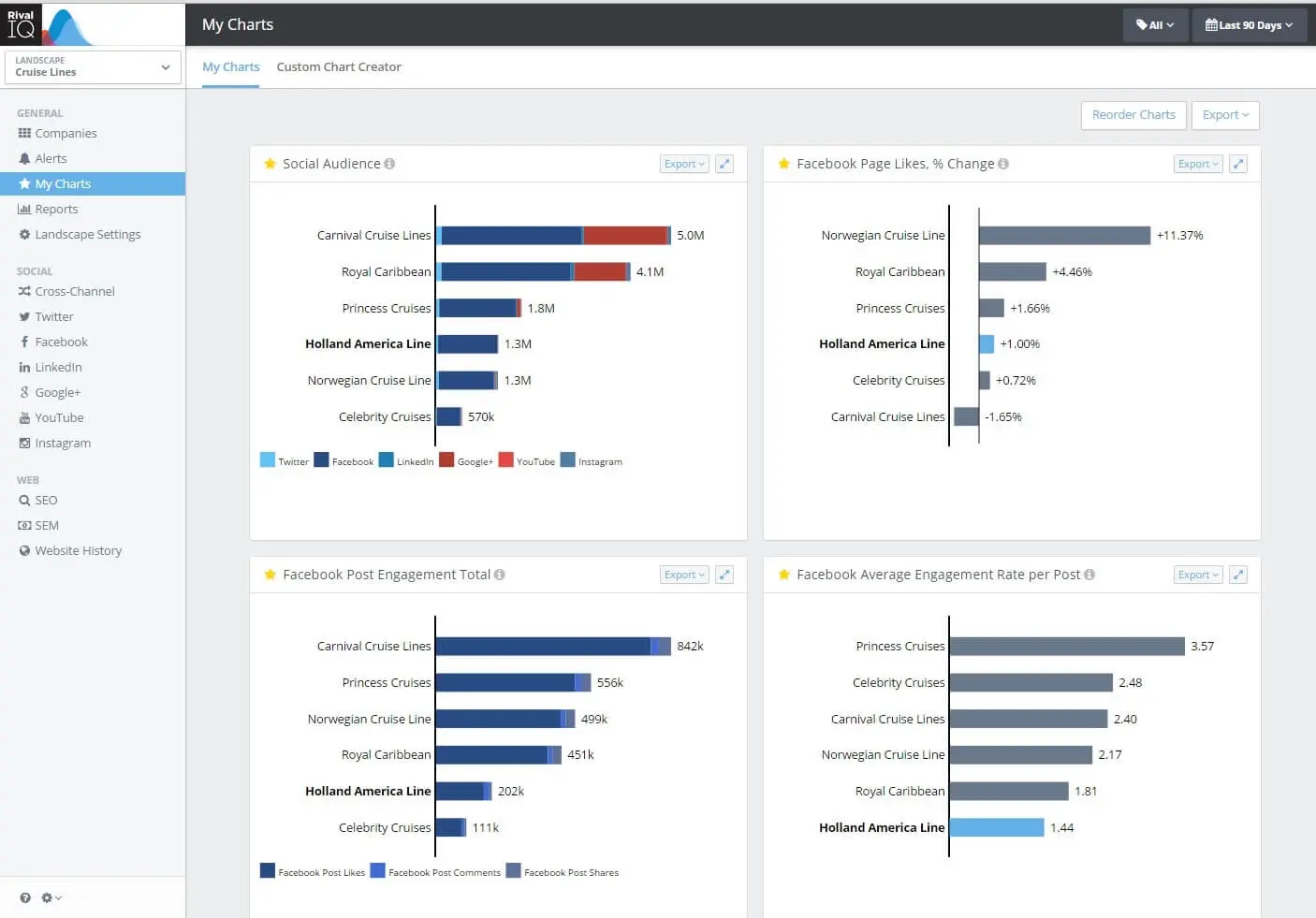
Tip: Doing the research is a waste of time if you don’t use what you learned to better your own company. Ask questions like, “How do they handle these issues?” “How are our competitors numbers?” “How do they compare to us?” Stay on top of how others are navigating through their campaigns and take notes on how you can do better.
 Social media marketing requires both strategy and creativity. While it may seem overwhelming, its importance cannot be overstated. It’s so important that >around 92% of marketers use social media as part of their marketing efforts. In addition to that, 78% of salespeople engaged in social media are outselling their peers who aren’t. Plus, its benefits extend far beyond increasing sales.
However, not all businesses are aware of the benefits of social media marketing. In fact, nearly 40% of small businesses don't use social media. Even more concerning is that an additional 16% are unlikely to use social media for business at all.
Clearly, there’s a disconnect between those who are seeing the benefits of social media and those struggling to get started. If the latter sounds like you, keep reading. You’re about to learn how social media marketing can help build your business. Some of the benefits you’ll learn about include:
Social media marketing requires both strategy and creativity. While it may seem overwhelming, its importance cannot be overstated. It’s so important that >around 92% of marketers use social media as part of their marketing efforts. In addition to that, 78% of salespeople engaged in social media are outselling their peers who aren’t. Plus, its benefits extend far beyond increasing sales.
However, not all businesses are aware of the benefits of social media marketing. In fact, nearly 40% of small businesses don't use social media. Even more concerning is that an additional 16% are unlikely to use social media for business at all.
Clearly, there’s a disconnect between those who are seeing the benefits of social media and those struggling to get started. If the latter sounds like you, keep reading. You’re about to learn how social media marketing can help build your business. Some of the benefits you’ll learn about include:
 Take AMI's Social Media Strategy Certification course to gain crucial social media marketing skills to run your social media successfully. This course gives you access to everything you need to create a results-driven social media strategy- including 8 premium templates, 11 video tutorials, and so much more!
Take AMI's Social Media Strategy Certification course to gain crucial social media marketing skills to run your social media successfully. This course gives you access to everything you need to create a results-driven social media strategy- including 8 premium templates, 11 video tutorials, and so much more!
 Take a look at Adidas' Twitter page. Adidas keeps their Twitter profile neat and clean. They place their recognizable logo on both their profile image and cover photo without being overbearing. This cover photo is especially effective because it showcases adidas’ products while enforcing their brand name.
Take a look at Adidas' Twitter page. Adidas keeps their Twitter profile neat and clean. They place their recognizable logo on both their profile image and cover photo without being overbearing. This cover photo is especially effective because it showcases adidas’ products while enforcing their brand name.

 Tip: Engage with your audience when they comment on your social media messages. Make sure they feel that there is a person behind the brand. Ensuring they feel like they’re not talking to a robot will give them a better perception of your company and make them feel more like a valued customer.
Focus on sharing content that naturally creates conversation. Some of those ways are to:
Tip: Engage with your audience when they comment on your social media messages. Make sure they feel that there is a person behind the brand. Ensuring they feel like they’re not talking to a robot will give them a better perception of your company and make them feel more like a valued customer.
Focus on sharing content that naturally creates conversation. Some of those ways are to:
 Take a look at Belk on Twitter. Their target audience’s interests align strongly with the women empowerment message portrayed in this tweet. By aligning themselves with the same value, they create a stronger bond with their target audience. If you’re unsure how to match your target customers’ interests, social listening can help.
Tip: Make it part of your daily routine to do some social listening and see what your target customers are talking about in your industry. If you want to take your social listening to the next level, check out Mention (the same social listening tool used by the CoSchedule team).
Take a look at Belk on Twitter. Their target audience’s interests align strongly with the women empowerment message portrayed in this tweet. By aligning themselves with the same value, they create a stronger bond with their target audience. If you’re unsure how to match your target customers’ interests, social listening can help.
Tip: Make it part of your daily routine to do some social listening and see what your target customers are talking about in your industry. If you want to take your social listening to the next level, check out Mention (the same social listening tool used by the CoSchedule team).
 Take this Starbucks post for example. They chose to share a video that tells the story of a customer who had a heartwarming experience at a Starbucks drive-through. Not only did they show how they impacted one of their customers, but they also spread the message that their product (or service) is effective enough for someone to give them positive feedback.
Tip: Not all stories have to be long and complicated. You can tell impactful and clear stories by using a simple image. As long as it tells a good story, it can effectively help your business’s public image.
Take this Starbucks post for example. They chose to share a video that tells the story of a customer who had a heartwarming experience at a Starbucks drive-through. Not only did they show how they impacted one of their customers, but they also spread the message that their product (or service) is effective enough for someone to give them positive feedback.
Tip: Not all stories have to be long and complicated. You can tell impactful and clear stories by using a simple image. As long as it tells a good story, it can effectively help your business’s public image.
 Take this example from Spotify's support Twitter account. A customer decided to ask a question via Twitter, and Spotify was able to answer it and help resolve the issue within a couple of hours.
Tip: Assuming that you have separate teams for social media and customer service, it’s important to maintain a strong line of communication between the two. That way, your teams don’t get tangled up when providing customer service through social media.
Take this example from Spotify's support Twitter account. A customer decided to ask a question via Twitter, and Spotify was able to answer it and help resolve the issue within a couple of hours.
Tip: Assuming that you have separate teams for social media and customer service, it’s important to maintain a strong line of communication between the two. That way, your teams don’t get tangled up when providing customer service through social media.

 Tip: Using a social media scheduling tool like CoSchedule's Marketing Calendar can help you plan your social media posts so your content can be found and be linked to.
Tip: Using a social media scheduling tool like CoSchedule's Marketing Calendar can help you plan your social media posts so your content can be found and be linked to.
 For example, Neil Patel frequently uses his tweets as Instagram posts. By doing this, he reaches those who might not have a Twitter account. If someone follows him on both platforms, this gives him an opportunity to show up on their feed more than once.
Tip: Repurposing content doesn’t just mean posting it in more than one place. You can slightly alter each post to make it more unique. For example, you can use social media to promote your podcast by posting a quote from your most recent guest on Twitter or Instagram. It won’t be exactly the same content, but a majority of the work is already done and this is a quick way to fill your social media calendar.
For example, Neil Patel frequently uses his tweets as Instagram posts. By doing this, he reaches those who might not have a Twitter account. If someone follows him on both platforms, this gives him an opportunity to show up on their feed more than once.
Tip: Repurposing content doesn’t just mean posting it in more than one place. You can slightly alter each post to make it more unique. For example, you can use social media to promote your podcast by posting a quote from your most recent guest on Twitter or Instagram. It won’t be exactly the same content, but a majority of the work is already done and this is a quick way to fill your social media calendar.
 Tip: There are some great retargeting tools out there that are easy to use. Check out those tools and find one that works for you. Use them to promote your product. But remember not to annoy your customer.
Tip: There are some great retargeting tools out there that are easy to use. Check out those tools and find one that works for you. Use them to promote your product. But remember not to annoy your customer.
 Tip: By using a social media calendar, you can plan your social media content ahead of time. Then, when it’s time to publish, you can just sit back and let the platforms do their jobs. You’ll be able to reach different audiences on each platform and really expand your reach.
Tip: By using a social media calendar, you can plan your social media content ahead of time. Then, when it’s time to publish, you can just sit back and let the platforms do their jobs. You’ll be able to reach different audiences on each platform and really expand your reach.
 Tip: When learning about industry changes, you’ll want to ask yourself questions to see how it might affect you and your company. Social media helps give you a steady stream of information you can use to see how your company measures up and how you might have to adjust your strategy.
Tip: When learning about industry changes, you’ll want to ask yourself questions to see how it might affect you and your company. Social media helps give you a steady stream of information you can use to see how your company measures up and how you might have to adjust your strategy.
 Tip: You can include buttons on your blog and website to display how many shares your content has gotten. These buttons are convenient and allow for quick sharing.
Tip: You can include buttons on your blog and website to display how many shares your content has gotten. These buttons are convenient and allow for quick sharing.
 When e.l.f. Cosmetics and Skincare announced they expanded where they were shipping products, a lot of people started talking about it. In just this one Instagram post, they received almost five thousand likes and over 200 comments.
Tip: So what type of news should you share?
When e.l.f. Cosmetics and Skincare announced they expanded where they were shipping products, a lot of people started talking about it. In just this one Instagram post, they received almost five thousand likes and over 200 comments.
Tip: So what type of news should you share?
 Tip: Establishing your company as a thought leader doesn’t happen overnight. If you want to be the first person people come to when they have a question, it’ll take some time. Start by asking questions about who you see as a thought leader. Ask questions like, “Who do I go to for answers?” “Who do others in my industry look to?” “How can I promote myself like they do?” Then, slowly take what you learn to make connections and drive discussion between your followers.
Tip: Establishing your company as a thought leader doesn’t happen overnight. If you want to be the first person people come to when they have a question, it’ll take some time. Start by asking questions about who you see as a thought leader. Ask questions like, “Who do I go to for answers?” “Who do others in my industry look to?” “How can I promote myself like they do?” Then, slowly take what you learn to make connections and drive discussion between your followers.
 Tip: TweetDeck is a social media listening tool that allows you to search for topics on Twitter to see what people’s opinions are about it. You can use this tool to see what consumers are saying about you and your competitors, along with any other keywords you might want insight on.
Tip: TweetDeck is a social media listening tool that allows you to search for topics on Twitter to see what people’s opinions are about it. You can use this tool to see what consumers are saying about you and your competitors, along with any other keywords you might want insight on.
 Tip: Doing the research is a waste of time if you don’t use what you learned to better your own company. Ask questions like, “How do they handle these issues?” “How are our competitors numbers?” “How do they compare to us?” Stay on top of how others are navigating through their campaigns and take notes on how you can do better.
Tip: Doing the research is a waste of time if you don’t use what you learned to better your own company. Ask questions like, “How do they handle these issues?” “How are our competitors numbers?” “How do they compare to us?” Stay on top of how others are navigating through their campaigns and take notes on how you can do better.


